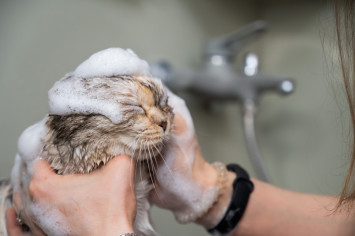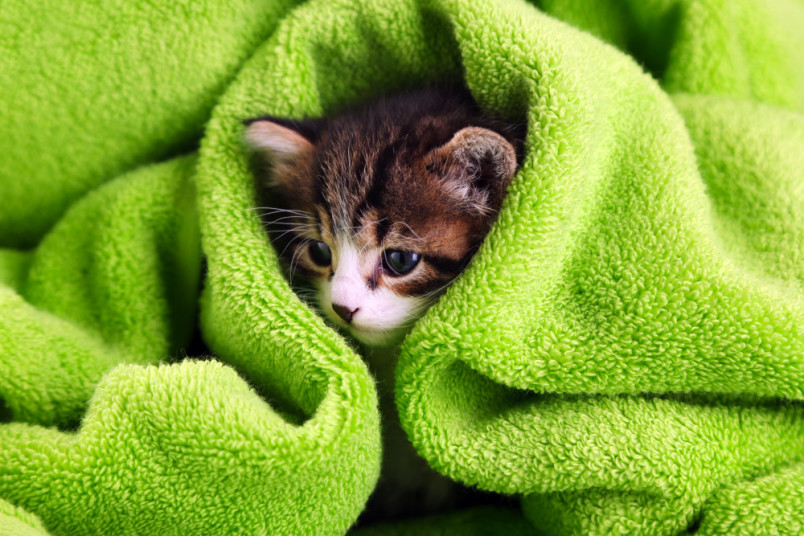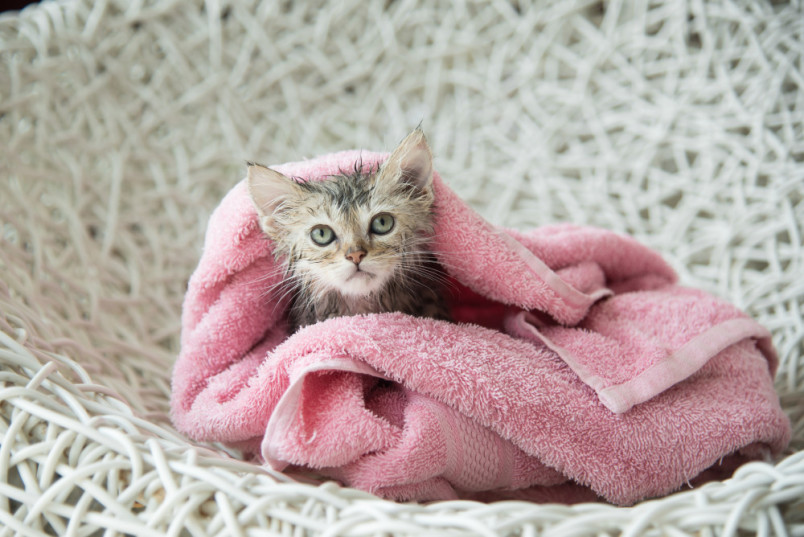
A mother cat spends the majority of her kitten’s awake time bathing them, and with good reason. Kittens are messy! Bathing a kitten is important to keep them clean and hygienic to help prevent illnesses, and of course, to make them snuggly soft. However, bathing a kitten comes with its fair share of difficulties. Even though they’re little, kittens can be little contortionists that will try to wriggle their way out of a bath in any way possible. Read on for some gentle techniques for how to bathe a kitten.
Tips for a Successful Kitten Bath
When bathing a kitten, preparation can be everything, and it starts well before you put your little bundle into the water.
Consider clipping your kitten’s nails beforehand so that errant scratches won’t be as severe. It’s also important to have your kitty’s nails trimmed regularly to prevent sore feet or infections from overgrown nails.
Brush their fur before wetting it to help keep snarls and mats from forming.
Enlist the help of another person that can hold your kitten in the water while your hands are all soapy or to hold the towel when you remove your baby from the bath.
Some cats don’t like water, some don’t mind it. Either way, be sure you’re not associating bad things with your kitten’s bath by staying calm, exercising patience, and allowing your kitten a little grace if they don’t take to the bathing thing right away. Some kittens may need to take baby steps when learning to bathe. This may mean starting with pet wipes and gradually adding water until they’re up for a full bath.

Preparing Your Kitten for the Bath
Acclimating the Kitten to Water
Your little kitty is going to be much more comfortable in the bath if they’ve had some water experience first. There are some great ways to acclimate your kitten to water, including playing with them in the empty tub, rubbing them with a wet washcloth, or gently pouring water over them while they get a treat or pets. You’ll want to work on this days or weeks in advance of the actual bath so that your kitten is as used to water as possible.
Gather Necessary Supplies
Don’t wait until you have a dripping wet kitten to get out the shampoo and towels. Instead, have all the supplies that you’ll need for the kitten bath ready to go beforehand. Not sure what those supplies are? Take a look:
Small tub, bowl, or sink
Kitten friendly shampoo
Cup for pouring water
Towels
Patience!
Choosing the Right Cat Shampoo
Kittens are babies after all, so they need a gentle shampoo preferably without any dyes or fragrances that could irritate the skin. Mild formulas meant for human babies work well or choose a cat-specific option. If you have questions about kitten-friendly shampoos, ask your vet.
Creating a Comfortable Environment
In order to make your kitten feel right at home in their bath, make it as comfortable as possible. Avoid loud noises, sudden movements, and make sure the room is warm so that your wet kitty doesn’t get cold.

Bathing the Kitten
Supplies are gathered, your kitty is relaxed, it’s go time! Almost. Fill the tub or sink with a couple inches of lukewarm water. Use the tried-and-true wrist-test method of dipping your wrist in the water to ensure the temperature is just right. Slowly introduce your baby to the water by first dipping their paws and then gently pouring small amounts on their legs and body by cupping water in your hand. Offer lots of praise and gentle, calming words.
Slowly lower your kitten in until they are standing in the water, and you can gently get their whole body-minus their face-wet. Once they’re wet, take a pea-sized amount of your chosen shampoo and lather it between your hands. Apply the lather to your kitten’s body, legs and feet using gentle circular motions. This is where having another person to help calmly hold your kitten in the tub may come in handy. Don’t apply any shampoo or water to your kitten’s face.
Thoroughly rinse your kitten using the cup to pour water over their body. Be sure to remove every bubble and soap sud to prevent skin irritation.
Drying and Calming the Kitten
Once your kitten is shampoo free and squeaky clean, it’s time to get them dry. Lift them from the water and into the open arms of a fluffy towel. Gently wrap them in the towel with their head sticking out and start to lightly caress them with the towel to remove water. Change to dry towels as needed so that you can remove as much moisture as possible.
Again, make sure you’re in a warm room to prevent your kitten from getting cold. Continue to offer lots of praise and calming words, even treats, to help them associate a kitten bath with positivity. Always watch them for any signs of distress, such as excessive crying, shivering, or aggression, and try to calm them when necessary.

When to Seek Professional Help
Bathing a kitten may seem like an easy, at-home task, but there are some cases when you may want to get a professional involved.
If a kitten has fleas, you’ll want to talk to your vet about gentle and safe treatments. If they are extremely dirty or have a medical condition that may be creating that mess (ie. diarrhea) or that requires special care, talk to your vet before giving a bath.
Another time to see your veterinarian is if your kitten shows any signs of illness after their bath. Things like skin irritation and respiratory issues may pop following baths, so be ready to recognize the signs for these and see your vet.
On this note, kittenhood is the purrfect time to look into kitten insurance. You want to get them a policy when they’re young to help pay for those up-and-coming expenses and to make sure they’re covered before they develop any health conditions, as these would be considered pre-existing and wouldn't be covered by insurance. When looking at those “how much is a kitten” costs, consider factoring in the price of pet health insurance as well. We also want your kitten to be safe, so you may want to also see how much does it cost to microchip a cat in order to protect your little ball of fur should they become lost.
Making Bath Time a Pawsitive Experience for Your Kitten
Remember, bathing your kitten is a learning process for both of you. By following these gentle techniques, remaining patient, and creating a positive experience, you can help your little one develop a healthy relationship with the bathtub and maintain their hygiene. Don't be discouraged if the first bath doesn't go smoothly - try again another day, and with each attempt, you'll both get more comfortable and confident. And most importantly, enjoy the precious moments of snuggling with your clean, fluffy kitten!